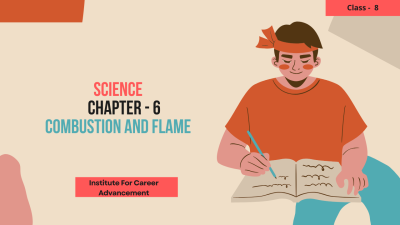| Outcomes |
- Here are the typical learning outcomes: Knowledge and Understanding Definition and Principles: Understanding Combustion: Students will be able to define combustion as a chemical process involving the rapid oxidation of a fuel in the presence of oxygen, resulting in heat and light. Principles of Flame Formation: They will understand how flames are formed during combustion, including the zones of a flame (inner cone, middle zone, outer non-luminous zone). Types and Characteristics: Differentiating Combustion Types: Students will distinguish between complete and incomplete combustion based on the availability of oxygen and the resulting products (CO2, CO, soot). Identifying Flame Characteristics: They will describe the characteristics of different flames, such as blue flames (complete combustion) and yellow/orange flames (incomplete combustion). Application and Skills Practical Applications: Everyday Uses: Students will recognize the practical applications of combustion in daily life, including cooking, heating, lighting, and transportation. Industrial Applications: They will understand how combustion is utilized in industries for power generation, manufacturing processes, and as a heat source. Experimental Skills: Conducting Experiments: Students will perform hands-on experiments to observe and analyze the process of combustion, factors affecting flame characteristics, and the effects of different fuels. Data Analysis: They will collect and interpret data from experiments to draw conclusions about combustion reactions and flame behavior. Critical Thinking and Analysis Environmental Impact: Understanding Pollution: Students will explore the environmental impacts of combustion, including air pollution (CO2, NOx, SO2, particulate matter) and its contribution to climate change. Discussing Solutions: They will critically evaluate strategies to reduce emissions and improve combustion efficiency for environmental sustainability. Safety and Fire Prevention: Fire Safety Awareness: Students will demonstrate knowledge of fire safety measures, including fire prevention, handling of flammable materials, and emergency response procedures. Risk Assessment: They will assess potential risks associated with combustion-related activities and propose measures to mitigate these risks in different contexts. Communication and Collaboration Effective Communication: Presenting Findings: Students will communicate their understanding of combustion and flame through oral presentations, written reports, and visual representations of experiments and case studies. Collaborative Learning: They will collaborate with peers in group activities to discuss combustion-related concepts, share ideas, and solve problems related to practical applications and environmental concerns.
- এখানে সাধারণ শেখার ফলাফলগুলি রয়েছেঃ জ্ঞান এবং বোঝার সংজ্ঞা এবং নীতিঃ দহন বোঝাঃ শিক্ষার্থীরা অক্সিজেনের উপস্থিতিতে জ্বালানির দ্রুত জারণ জড়িত একটি রাসায়নিক প্রক্রিয়া হিসাবে দহনকে সংজ্ঞায়িত করতে সক্ষম হবে, যার ফলে তাপ এবং আলো হয়। শিখা গঠনের নীতিঃ তারা বুঝতে পারবে কিভাবে একটি শিখার অঞ্চল সহ জ্বলন চলাকালীন শিখা তৈরি হয়। (inner cone, middle zone, outer non-luminous zone). প্রকার ও বৈশিষ্ট্যঃ জ্বলন প্রকারের পার্থক্যঃ শিক্ষার্থীরা অক্সিজেনের প্রাপ্যতা এবং ফলস্বরূপ পণ্যগুলির উপর ভিত্তি করে সম্পূর্ণ এবং অসম্পূর্ণ জ্বলন মধ্যে পার্থক্য করবে (CO2, CO, soot). অগ্নিকুণ্ডের বৈশিষ্ট্যগুলি সনাক্ত করাঃ তারা নীল শিখা (সম্পূর্ণ জ্বলন) এবং হলুদ/কমলা শিখা হিসাবে বিভিন্ন শিখার বৈশিষ্ট্যগুলি বর্ণনা করবে। (incomplete combustion). প্রয়োগ ও দক্ষতা ব্যবহারিক প্রয়োগঃ দৈনন্দিন ব্যবহারঃ শিক্ষার্থীরা রান্না, গরম করা, আলো এবং পরিবহন সহ দৈনন্দিন জীবনে জ্বলন ব্যবহারিক প্রয়োগগুলি চিনতে পারবে। শিল্প ক্ষেত্রে প্রয়োগঃ তাঁরা বুঝতে পারবেন কিভাবে বিদ্যুৎ উৎপাদন, উৎপাদন প্রক্রিয়া এবং তাপের উৎস হিসাবে শিল্পগুলিতে জ্বলন ব্যবহার করা হয়। পরীক্ষামূলক দক্ষতাঃ পরীক্ষা-নিরীক্ষা পরিচালনাঃ শিক্ষার্থীরা দহন প্রক্রিয়া, শিখার বৈশিষ্ট্যকে প্রভাবিত করে এমন কারণ এবং বিভিন্ন জ্বালানির প্রভাব পর্যবেক্ষণ ও বিশ্লেষণের জন্য হাতে-কলমে পরীক্ষা-নিরীক্ষা করবে। তথ্য বিশ্লেষণঃ তারা দহন প্রতিক্রিয়া এবং শিখা আচরণ সম্পর্কে সিদ্ধান্ত নিতে পরীক্ষা-নিরীক্ষা থেকে তথ্য সংগ্রহ এবং ব্যাখ্যা করবে। সমালোচনামূলক চিন্তা ও বিশ্লেষণ পরিবেশগত প্রভাবঃ দূষণ বোঝাঃ শিক্ষার্থীরা বায়ু দূষণ (সিও 2, এনওএক্স, এসও 2, পার্টিকুলেট ম্যাটার) এবং জলবায়ু পরিবর্তনে এর অবদান সহ জ্বলন পরিবেশগত প্রভাবগুলি অন্বেষণ করবে। সমাধান নিয়ে আলোচনাঃ তারা পরিবেশগত স্থায়িত্বের জন্য নির্গমন হ্রাস এবং দহন দক্ষতা উন্নত করার কৌশলগুলি সমালোচনামূলকভাবে মূল্যায়ন করবে। নিরাপত্তা ও অগ্নি প্রতিরোধঃ অগ্নি নিরাপত্তা সচেতনতাঃ শিক্ষার্থীরা অগ্নি প্রতিরোধ, দাহ্য পদার্থ পরিচালনা এবং জরুরি প্রতিক্রিয়া পদ্ধতি সহ অগ্নি নিরাপত্তা ব্যবস্থা সম্পর্কে জ্ঞান প্রদর্শন করবে। ঝুঁকি মূল্যায়নঃ তারা দহন-সম্পর্কিত ক্রিয়াকলাপের সাথে সম্পর্কিত সম্ভাব্য ঝুঁকিগুলি মূল্যায়ন করবে এবং বিভিন্ন প্রসঙ্গে এই ঝুঁকিগুলি হ্রাস করার ব্যবস্থা প্রস্তাব করবে। যোগাযোগ ও সহযোগিতা কার্যকর যোগাযোগঃ ফলাফল উপস্থাপনঃ শিক্ষার্থীরা মৌখিক উপস্থাপনা, লিখিত প্রতিবেদন এবং পরীক্ষা-নিরীক্ষা এবং কেস স্টাডির ভিজ্যুয়াল উপস্থাপনের মাধ্যমে জ্বলন এবং শিখা সম্পর্কে তাদের বোঝার যোগাযোগ করবে। সহযোগিতামূলক শিক্ষাঃ তারা দহন-সম্পর্কিত ধারণাগুলি নিয়ে আলোচনা করতে, ধারণাগুলি ভাগ করে নিতে এবং ব্যবহারিক প্রয়োগ এবং পরিবেশগত উদ্বেগ সম্পর্কিত সমস্যাগুলি সমাধান করতে গ্রুপ ক্রিয়াকলাপে সহকর্মীদের সাথে সহযোগিতা করবে।
|
|
|
| Requirements |
- Combustion is a fundamental chemical process that involves the rapid oxidation of fuels in the presence of oxygen, resulting in the release of heat and light. Understanding this process helps explain how energy is generated from various fuels, such as wood, coal, natural gas, and petroleum. Understanding combustion contributes to discussions about global energy policies, environmental sustainability, and climate change mitigation strategies. It prepares students to engage in informed debates and make responsible decisions regarding energy use and environmental stewardship. Studying Combustion and Flame is essential because it provides a comprehensive understanding of fundamental chemical processes, their practical applications, environmental impacts, and societal implications. It equips students with knowledge and skills that are critical for addressing energy challenges, promoting sustainability, and making informed decisions in a complex and interconnected world.
- দহন একটি মৌলিক রাসায়নিক প্রক্রিয়া যা অক্সিজেনের উপস্থিতিতে জ্বালানির দ্রুত জারণের সাথে জড়িত, যার ফলে তাপ এবং আলো মুক্তি পায়। এই প্রক্রিয়াটি বোঝা কাঠ, কয়লা, প্রাকৃতিক গ্যাস এবং পেট্রোলিয়ামের মতো বিভিন্ন জ্বালানি থেকে কীভাবে শক্তি উৎপন্ন হয় তা ব্যাখ্যা করতে সহায়তা করে। দহন বোঝার বৈশ্বিক শক্তি নীতি, পরিবেশগত স্থায়িত্ব এবং জলবায়ু পরিবর্তন প্রশমন কৌশল সম্পর্কে আলোচনায় অবদান রাখে। এটি শিক্ষার্থীদের অবহিত বিতর্কে জড়িত হতে এবং শক্তির ব্যবহার ও পরিবেশগত তত্ত্বাবধানের বিষয়ে দায়িত্বশীল সিদ্ধান্ত নিতে প্রস্তুত করে। দহন এবং শিখা অধ্যয়ন অপরিহার্য কারণ এটি মৌলিক রাসায়নিক প্রক্রিয়া, তাদের ব্যবহারিক প্রয়োগ, পরিবেশগত প্রভাব এবং সামাজিক প্রভাব সম্পর্কে একটি বিস্তৃত ধারণা প্রদান করে। এটি শিক্ষার্থীদের জ্ঞান এবং দক্ষতার সাথে সজ্জিত করে যা শক্তির চ্যালেঞ্জ মোকাবেলা, স্থায়িত্ব প্রচার এবং একটি জটিল এবং আন্তঃসংযুক্ত বিশ্বে অবহিত সিদ্ধান্ত গ্রহণের জন্য গুরুত্বপূর্ণ।
|
|
|


 0
0 